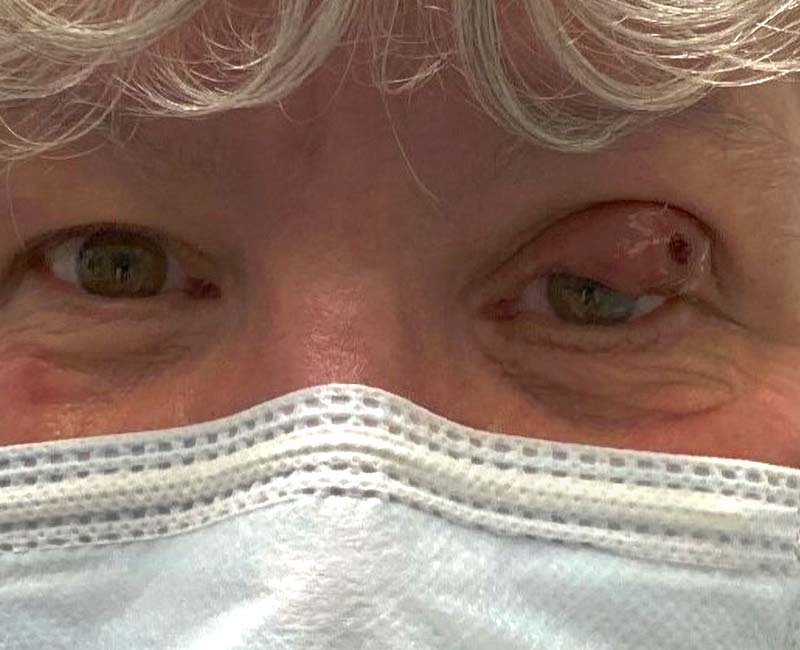Periorbital cellulitis (preseptal cellulitis) is a bacterial infection that causes swelling in the skin around your eye. It often affects younger children. It’s not serious and not painful, but it does need antibiotics to go away. If it spreads into tissues under the skin, it could become more serious.
Advertisement
Cleveland Clinic is a non-profit academic medical center. Advertising on our site helps support our mission. We do not endorse non-Cleveland Clinic products or services. Policy

Periorbital cellulitis is a bacterial (or viral) infection in your eyelid or the skin around your eye. Peri- means “around,” so periorbital means “surrounding your orbit,” which is your eye socket. This condition mostly affects young children. It makes the skin around their eyes puffy and swollen. But it usually doesn’t cause discomfort. It’s a superficial skin infection that goes away quickly with antibiotics.
Advertisement
Cleveland Clinic is a non-profit academic medical center. Advertising on our site helps support our mission. We do not endorse non-Cleveland Clinic products or services. Policy
Cellulitis isn’t always superficial — it can sometimes spread to the deeper layers of your skin and the tissues beneath it. This is why healthcare providers have begun using the term, “preseptal cellulitis” to describe periorbital cellulitis. “Preseptal” means “in front of the septum,” which is the membrane that separates the skin around your eyes from the other tissues that lie deeper inside your eye socket.
Preseptal cellulitis could become a more serious condition if the infection spreads beyond the septum, to the deeper layers of skin and other tissues in your eye socket (orbit). This is called orbital cellulitis. It causes additional symptoms and is much more dangerous than periorbital cellulitis. If you or your child develops a fever with pain and swelling all around the eye socket, you should seek immediate care.
Periorbital cellulitis symptoms may include:
It doesn’t cause eye pain or fever. Swelling occurs in the skin, but not in the deeper tissues around or behind the eye. Swelling behind the eye can make it bulge, which is one way to tell the difference.
Advertisement
Bacteria that infect the skin around your eye usually cause preseptal cellulitis. They often get into your skin from a sinus infection or a flesh wound. Sometimes, the infection spreads from somewhere else.
They may come from:
Your child might be more likely to get preseptal cellulitis if they:
Periorbital cellulitis isn’t contagious. Since the infection is within your skin, it won’t spread by contact with another person. If your child had an open, infected wound, the bacteria in that wound could spread by contact with another person. But it wouldn’t cause an infection unless they also had an open wound.
To diagnose periorbital (preseptal) cellulitis, healthcare provider will examine the area around your child’s eye. They’ll ask about any recent injuries, bites or infections. They might order imaging tests, like a CT scan or MRI, to see the deeper tissues around the eye if the area is very swollen. They might want to take a sample of infected fluids, like eye discharge or nasal discharge, to do a bacterial culture test.
Periorbital cellulitis needs treatment with antibiotics. In most cases, your child can take them in pill form at home. The infection usually goes away after about a week. If your child has a really bad infection, or their immune system is weaker for any reason, your provider might prefer that they stay in the hospital and receive antibiotics through a tube in their vein (IV). This gets the medicine to their tissues faster.
Contact your provider right away when you notice symptoms of periorbital cellulitis. Although it isn’t serious itself, it can turn into a more serious condition if it doesn’t get prompt treatment. Be sure to contact your provider if your child’s symptoms aren’t improving with treatment, or if they get worse.
Go to the emergency room if your child develops:
You might want to ask:
You can reduce your child’s risk of periorbital cellulitis if you:
Advertisement
Periorbital cellulitis looks alarming, and it might upset your child if swelling closes their eye. But it shouldn’t cause them pain, and you can let them know it will get better quickly with medicine. See your provider as soon as you can, though. Preseptal cellulitis won’t go away on its own, and it can spread. If it does, it can quickly become more serious and more uncomfortable for your child.
Advertisement
When you need care for your child’s vision, it’s important to find someone you trust. Cleveland Clinic Children's experts focus on your child's needs.

Last reviewed on 01/29/2025.
Learn more about the Health Library and our editorial process.